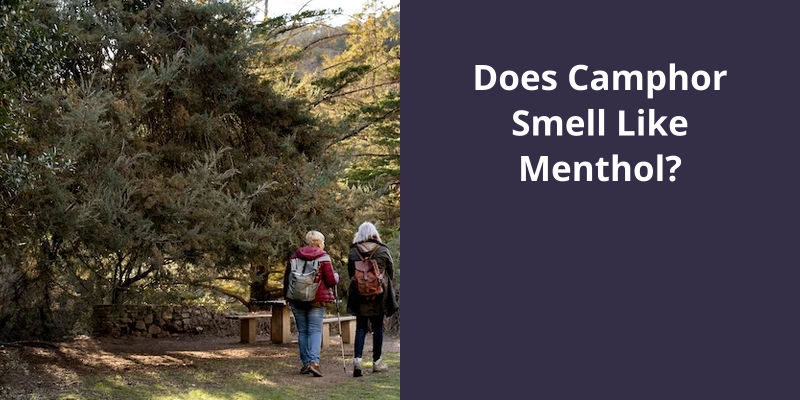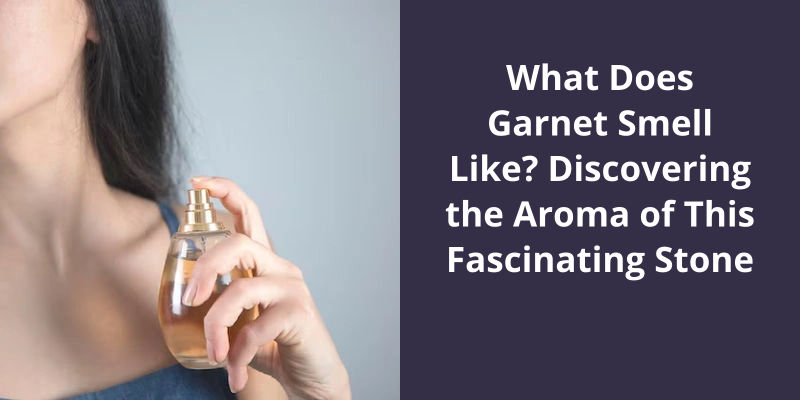Camphor and menthol do share a similar cooling and penetrating aroma, but they are not exactly the same in terms of scent. Camphor has a strong, sharp and somewhat woody smell which might remind you of Vicks VapoRub, since it’s one of the main ingredients. On the other hand, menthol has a refreshing minty smell, often associated with peppermint or spearmint. Both scents are potent and can clear the nostrils, but while camphor leans towards a medicinal, mothball-like odor, menthol has a distinctly cleaner and fresher mint-like odor.

What Trees Smell Like Menthol?
When it comes to trees that smell like menthol, one of the most prominent examples is the camphor tree. With it’s unmistakable aroma, camphor emits a strong menthol odor when it’s leaves and twigs are crushed. This distinctive scent is often associated with the soothing properties of menthol, making it a popular choice for various medicinal and therapeutic purposes.
However, it’s important to note that camphor trees possess certain characteristics that can be problematic. Despite being a fast-growing species, camphor trees tend to develop poor structure over time. This, coupled with their susceptibility to decay, puts them at a higher risk of experiencing branch failure or even toppling entirely, even during relatively mild storms.
Due to these potential dangers, it’s crucial to properly maintain and monitor camphor trees, especially in areas prone to severe weather conditions. Regular pruning and structural evaluations are necessary to ensure the trees stability and reduce the risk of accidents or property damage.
Despite these concerns, the aromatic benefits of camphor trees shouldn’t be overlooked. However, it’s essential to strike a balance between appreciating their pleasing fragrance and being aware of their structural limitations.
But what’s it about camphor that makes it’s scent so appealing to some people?
Why Do I Like the Smell of Camphor?
Camphor, with it’s unique aroma, has captivated my olfactory senses for as long as I can remember. The enticing fragrance of camphor not only appeals to my senses, but also sparks a curiosity within me as to why I’m inexplicably drawn to it’s scent. Despite it’s pungent nature, camphor possesses a refreshing quality that envelops the air, leaving behind an invigorating aura.
From childhood memories of using Vicks VapoRub during times of illness, the distinctive smell of camphor has been etched into my mind. The association of camphor with healing and comfort further enhances it’s appeal, as it evokes a sense of warmth, care, and nostalgia.
The Various Uses of Camphor in Traditional Medicine and Aromatherapy
- Camphor is commonly used in traditional medicine for it’s analgesic properties.
- It’s also used as an expectorant to help relieve cough and congestion.
- In aromatherapy, camphor is used to promote relaxation and reduce anxiety.
- It can be applied topically to treat skin conditions such as itching and irritation.
- Camphor oil is often used in massage therapy to soothe sore muscles and joints.
- It’s believed to have antiseptic and anti-inflammatory effects when used externally.
- In traditional Chinese medicine, camphor is used to treat various respiratory conditions.
- It can also be found in some insect repellents due to it’s strong scent.
- Camphor is sometimes used in the manufacturing of ointments and balms for pain relief.
- Additionally, it’s believed to have spiritual and symbolic significance in certain cultures.
The smell of camphor is truly unique and unlike anything else, making it difficult to put into words. However, it can be best described as a combination of prickly, woody, herbal, and spicy notes that evoke a cooling sensation, with hints of earthiness and a resemblance to naphtha (commonly known as moth balls).
How Do You Describe the Smell of Camphor?
When it comes to describing the smell of camphor, it’s difficult to find words that truly capture it’s unique aroma. The scent of camphor is highly distinctive and unlike anything else, making it hard to confuse it with any other fragrance. However, attempting to describe it requires some creativity, as it’s complexities aren’t easily captured in traditional olfactory terms.
It possesses a certain sharpness that’s at once refreshing and energizing. This quality is often likened to the cool, menthol-like sensation that camphor delivers, providing a sense of crispness and awakening to the senses.
In addition to it’s prickly nature, camphor also carries hints of a woody and herbal character. It possesses an earthy undertone that adds depth to it’s overall fragrance profile. This aspect intertwines with it’s partially spice-like aroma, giving it a warm and inviting quality that can evoke a sense of comfort.
Furthermore, the smell of camphor bears a slight similarity to naphthalene, commonly referred to as moth balls. This comparison can be attributed to the fact that naphthalene is often derived from camphor. However, it’s important to note that camphor’s fragrance is much more complex and nuanced than that of moth balls, as it possesses it’s own distinct qualities.
The scent of menthol is often associated with eucalyptus as both it’s essential oil and certain parts of the tree emit a similar fragrance when crushed. This aromatic characteristic of eucalyptus leaves, twigs, or bark, along with the camphor tree, has been utilized for it’s unique scent in various applications.
Does Eucalyptus Smell Like Menthol?
Camphor and menthol are both organic compounds that possess distinct aromatic properties. While they may share certain olfactory similarities, they aren’t identical in terms of the scents they emanate. The essential oil derived from eucalyptus, which contains compounds like eucalyptol, contributes to it’s characteristic smell. This scent is often described as fresh, crisp, and slightly medicinal. On the other hand, camphor is known for it’s distinctive, pungent aroma that’s often associated with healing and muscle-relaxing properties.
It’s important to note that while eucalyptus may have a menthol-like smell when crushed, it doesn’t contain actual menthol. Menthol is a compound primarily derived from mint plants, such as peppermint and spearmint. It’s widely used for it’s cooling effects and distinctive aroma, which is often associated with soothing respiratory conditions.
Understanding these distinctions can help differentiate between the scents and properties of these two compounds.
Native to China and Japan, Cinnamomum camphora is a tree that boasts a distinctive scent resembling camphor. The shiny green leaves of this tree emit this fragrance when crushed, making it easily identifiable. In addition to it’s aromatic qualities, these camphor trees possess an impressive growth rate and can produce significant quantities of shiny black berries. Interestingly, birds readily consume these berries, facilitating seed dispersal across their habitats.
What Tree Smells Like Camphor?
The camphor tree, scientifically known as Cinnamomum camphora, emits a distinctly fragrant smell akin to the scent of camphor when it’s leaves are crushed. This tree is found in abundance in both China and Japan, where it’s native. It’s shiny green leaves have a characteristic fragrance that sets it apart from other trees. Interestingly, the camphor tree exhibits rapid growth, allowing it to reach considerable heights in a short span of time. Additionally, it possesses the unique ability to produce vast quantities of shiny black berries.
Remarkably, these berries serve as a prime source of nourishment for birds, subsequently facilitating the dispersion of the trees seeds. This process aids in the propagation of the camphor tree throughout it’s natural habitat. Moreover, the glossy appearance of these berries enhances their visual appeal to birds, prompting them to consume and disperse the seeds in various locations. This mechanism contributes to the ongoing renewal and expansion of the camphor tree population across China and Japan.
This resemblance to the scent of menthol is perhaps due to the high concentration of camphor oil in the tree. Both camphor and menthol are known for their cooling properties and have been widely utilized throughout history for their medicinal attributes.
Native to China and Japan, this tree exhibits rapid growth and produces ample amounts of black berries, thereby facilitating it’s dispersal through bird consumption. Consequently, the similarities in fragrance between camphor and menthol have been noted and utilized for various purposes.
Uses of Camphor in Traditional Medicine and Modern Uses in Pharmaceuticals
Camphor has been used for centuries in traditional medicine around the world. It’s commonly used as a natural remedy for various ailments such as coughs, colds, and congestion. The distinct scent of camphor is often associated with it’s medicinal properties.
In modern pharmaceuticals, camphor is used in a variety of ways. It’s a common ingredient in topical pain relief products, as it can provide a cooling effect when applied to the skin. Camphor is also used in some cough syrups and lozenges for it’s soothing properties.
It’s important to note that while camphor and menthol share similar characteristics, they aren’t the same. Camphor has a sharper scent compared to the cooling and minty scent of menthol. Therefore, camphor doesn’t smell exactly like menthol, although it does have it’s own distinct aroma.
Conclusion
This similarity in smell can be helpful in identifying camphor, as it allows for quick and easy recognition.





